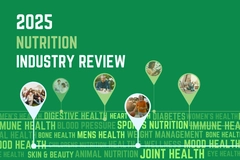
- Industry news
Industry news
- Category news
- Reports
- Key trends
- Multimedia
Multimedia
- Journal
- Events
- Suppliers
Suppliers
- Home
- Industry news
Industry news
- Category news
- Reports
- Key trends
- Multimedia
Multimedia
- Events
- Suppliers
Suppliers
UC Davis bets on innovative university start-ups to disrupt the food system

12 Aug 2024 --- The University of California (UC) Davis, US, has created an environment where research and industry join forces to develop innovations in the food system, driven by the university’s Innovation Institute for Food and Health (IIFH). University start-ups are vital in creating “challengers to legacy companies” and disrupting the food system, says Justin Siegel, IIFH’s faculty director and a professor in Biochemistry and Molecular Medicine, the Genome Center and entrepreneurship.
When Siegel joined UC Davis, the university generated almost no start-ups, even though universities have a long history of start-ups, which he says are crucial for innovation. “Innovation is fundamentally defined in the sense of new technologies, creating new marketplaces or disrupting marketplaces,” he tells Nutrition Insight.
“We were generating phenomenal first-in-class, best-in-class talent and first-in-class, best-in-class talent knowledge and knowledge transfer, but there’ve been zero start-ups in this space, zero commercial products in this space.”
Therefore, Siegel joined a group of faculty members with a vision and strategy to obtain a significant portion of the US$1 billion the university spends on R&D annually for the food system and to build commercial enterprises.
Since then, the university has built a food and health “ecosystem” for innovative research to solve global nutrition challenges. The IIFH plays a significant role in this transition to innovation. The institute builds on use-inspired research and developing the “workforce of the future.”
University start-ups
Siegel details a long history of start-ups, noting that these are usually sector-driven. “For a start-up to emerge or a series of start-ups to emerge, you need domain expertise to understand the system you’re trying to disrupt and bring in new ideas, new ways of thinking and new capabilities into that system you’re disrupting,” he explains.
“If you go back to the 50s, 60s or 70s, universities were an Ivory Tower. They were very against academic-industry relationships and start-ups were non-existent. You started seeing start-ups in the 80s and 90s, and the biopharmaceutical sector drove it.”
He links this to the genetics revolution when scientists realized they could read and start manipulating DNA rationally. This led to a group of biopharmaceutical start-ups and the start of the “biopharmaceutical revolution.”
 Justin Siegel, faculty director of IIFH and professor at UC Davis (Image credit: UC Davis Genome Center).“If you look at the drugs and therapeutics in the world today, it went from dominated by chemists and small molecules to biopharmaceuticals and biologics. They stem from all those start-ups,” says Siegel.
Justin Siegel, faculty director of IIFH and professor at UC Davis (Image credit: UC Davis Genome Center).“If you look at the drugs and therapeutics in the world today, it went from dominated by chemists and small molecules to biopharmaceuticals and biologics. They stem from all those start-ups,” says Siegel.
“That’s what you had UC San Francisco, MIT and Harvard — a lot of start-ups came from these universities because they have the domain expertise in that area. The same thing happened in the 90s and early 2000s with information technology.”
He points to an IT company wave from domain expertise nodes as people realized the potential of IT in industries.
Food tech wave
UC Davis’s core foundation, capabilities and assets are in sustainable food systems. Siegel explains that the university “never had the right to be the first movers and players” in the biopharmaceutical and information technology waves. Some start-ups came out of the university, but they were not focused on food technology “since there weren’t many start-ups in food tech generally.”
“Since about 2010, we’ve had this wave of food tech and food biotechnology,” he continues. “This is where Davis has had this opportunity to say, we have a chance to become leaders in this field. This is our area; the world is ready to disrupt the food system.”
Siegel highlights that introducing a challenger to legacy companies is the only way to disrupt the food system. Although these companies have a role, they need a challenger to “dramatically shift it.”
Disruptions must come from a challenger on the outside, which “helps steer the ship — a little tugboat that pushes the bigger vessel away from the iceberg. We needed some of those.”
At the same time, the food sector also needs large companies to scale and distribute new solutions.
However, at the time, UC Davis did not have the support system to help students create start-up companies and technologies.
Creating a supportive environment
Siegel connected with other faculty members with experience in legacy sectors and starting organizations to create an environment at UC Davis to catalyze the capabilities needed to start new companies.
.jpg) Siegel joined the UC Davis faculty, aiming to work on building ventures by testing out new technologies.He adds that at the university, a large share of undergraduate and graduate students and faculty members are first-generation students. “They’re the first generation to go to higher education and get a college degree.”
Siegel joined the UC Davis faculty, aiming to work on building ventures by testing out new technologies.He adds that at the university, a large share of undergraduate and graduate students and faculty members are first-generation students. “They’re the first generation to go to higher education and get a college degree.”
This brings an added cultural challenge, enticing students to start a company instead of getting a stable job. “Especially when you’re in an environment where no one’s ever started a company before, a challenger organization to help shift the legacy organizations. If you’re looking around and no one’s ever done it around you, and you’ve come from an upbringing where you’re the pioneer of the family, the first to go to college, that’s a heavy lift for anyone.”
“A lot of what we’re doing is how we help support these students. How do we provide paths, provide teams and make them understand they’re not alone and competent.”
De-risk technology development
Meanwhile, Siegel comes from a family of entrepreneurs. Intending to build an investment fund with his father, he realized “we were in this unique period where universities were trying to help support and think about promoting the launching of challenger companies to help complement the efforts they’re doing.”
Therefore, Siegel joined the UC Davis faculty, aiming to work on building ventures through this mechanism.
“I can prototype technologies in my lab, and if it doesn’t work, e.g., if the idea flops or fails or we aren’t able to hit the technical metrics, I can still publish it, and I have trained students — it’s a good solid academic endeavor.”
“If it does work and we hit the metrics we were looking to hit with the technologies, we can patent it. We can form a team, finance it, build our business plan and publish it at the right time. Then the student can choose whether they want to join that company.”
He explains this is a way to de-risk technology development.
“It’s a win-win. If it works, we’ll go commercial, but if it doesn’t work, we’ll go academic.”
Biomedical start-up
Before Siegel joined UC Davis, he says he mainly saw the university as a testbed for its laboratory and initially did not think about the food system, as he focused on biomedical applications.
“I developed a company when I finished graduate school and started here at Davis. We had developed a pill where if you have gluten intolerance, very specifically celiac disease, and you were worried about exposure, you would be able to take and have an aura of protection for an hour.”
 Siegel’s research team developed a pill with an enzyme targeting triggers of celiac disease to protect people from the disease.He explains that the concept was similar to the lactate pill but then targeting triggers of celiac disease symptoms, which is a pervasive problem for people with the disease.
Siegel’s research team developed a pill with an enzyme targeting triggers of celiac disease to protect people from the disease.He explains that the concept was similar to the lactate pill but then targeting triggers of celiac disease symptoms, which is a pervasive problem for people with the disease.
“Imagine if they just had a pill where they could go out and do what they want — it’s life-changing for that population,” he emphasizes. “We leveraged computational and modern biotechnology tools on the enzyme discovery side.”
Siegel explains that he had been working on these concepts since his time on the Human Genome Project — a biological discovery project led by an international group of researchers looking to study the genome of a select set of organisms. Since his time on the project, technologies have kept advancing.
“We could leverage all those advanced technologies to build an enzyme, a protein that is ultra-specific and optimized for the environment that we need, the stomach in this case, with a complex matrix of different foods to go target those pieces that you don’t want and get rid of them. We were able to build that, and then we realized this works well. We spun out a company and sold that eventually to Takeda Pharmaceuticals.”
Food system impact
While Siegel saw this research as part of a biomedical framework, a UC Davis food science team professor realized its impact on the food system. “He said — you took a highly desired, commodity agricultural crop that we can make in a highly sustainable, productive way, and you took a human function that didn’t work with that system and you did it specifically around protein.”
“You didn’t have to say, ‘hey, person, change your life,’ or ‘hey, agriculture, change your entire supply chain.’ You just made the protein that the agricultural system knows how to make, which is highly desired by people, and made those work together.”
Siegel notes that this research can be replicated to other proteins and ingredients. He notes that there are many proteins that humans don’t digest or don’t digest efficiently. At the same time, the world needs a larger supply of protein, one of the most intensive forms of agriculture in terms of carbon emissions.
“The world’s saying we need to lower our climate or agricultural footprint, but we need to double the production of the most difficult substance on Earth, which is essential for life. If you can double the efficacy of proteins without changing the system, that solves the equation,” he concludes.
By Jolanda van Hal











